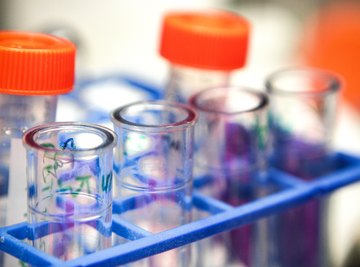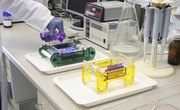
When it comes to measuring the length of DNA fragments, which are much smaller than cells, microbiologists need a trick, and the most convenient one is gel electrophoresis. This method relies on the fact that DNA fragments are charged, and it is an alternative to more expensive methods, such as X-ray crystallography, which was responsible for the discovery of the double-helix structure of DNA.
How Gel Electrophoresis Works
Because DNA molecules are charged, they are affected by an electric current. When you set them in a neutral gel and place a current across the gel, the molecules migrate toward the positive electrode (anode). Because DNA molecules of different sizes carry the same charge, the smaller ones travel faster, so this process separates the molecules into bands that can be compared to samples of known sizes.
A Basic Electrophoresis Procedure
The gel is usually made from agarose, a polysaccharide that when heated in a buffer solution forms a semi-solid, slightly porous gel. At one end, the gel forms tiny indentations called wells where the researcher places the DNA samples under study, along with reference samples of known length, called a DNA ladder. The lengths of the ladder fragments have been pre-determined by another method, such as X-ray crystallography.
When the gel is immersed in a conducting solution and voltage is applied, the fragments begin migrating through the gel – the smaller ones first and the larger, slower ones behind. They eventually form themselves into spectrum-like bands according to size.
Once this occurs, the researcher turns off the power, infuses the gel with a DVA-binding dye and examines the specimens under ultraviolet light. Using the ladder as a reference, the researcher can determine the size of each of the fragments in a visible band. Only bands are visible – individual DNA fragments are too small to see.
Determining Lengths of Unknown Fragments
Chances are not every band in a sample pairs up with a band on the ladder, so to determine the sizes of these unknown fragments, scientists usually plot a graph. On the x-axis is the distance traveled by each band in the ladder in millimeters, while on the y-axis is the size of each band. When the points are connected by a curve, the size of any band can be extrapolated from the curve after measuring the distance traveled by that band in millimeters.
About the Author
Chris Deziel holds a Bachelor's degree in physics and a Master's degree in Humanities, He has taught science, math and English at the university level, both in his native Canada and in Japan. He began writing online in 2010, offering information in scientific, cultural and practical topics. His writing covers science, math and home improvement and design, as well as religion and the oriental healing arts.
